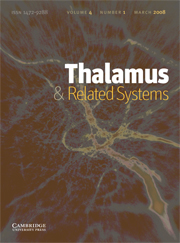Article contents
Modulation of a Ca2+-dependent K+-current by intracellular cAMP in rat thalamocortical relay neurons
Published online by Cambridge University Press: 12 April 2006
Abstract
Voltage-activated calcium channels in thalamic neurons are considered important elements in the generation of thalamocortical burst firing during periods of electroencephalographic synchronization. A potent counterpart of calcium-mediated depolarization may reside in the activation of calcium-dependent potassium conductances. In the present study, thalamocortical relay cells that were acutely disso-ciated from the rat ventrobasal thalamic complex (VB) were studied using whole-cell patch-clamp techniques. The calcium-dependent potassium-current (IK(Ca)) was evident as a slowly activating component of outward current sensitive to the calcium ions (Ca2+)-channel blocker methoxyverapamil (10 μM) and to substitution of external calcium by manganese. The IK(Ca) was blocked by tetraethylam-monium chloride (1 mM) and iberiotoxin (100 nM), but not apamin (1 μM). In addition, isolated VB neurons were immunopositive to anti-α(913–926) antibody, a sequence-directed antibody to the a-subunit of “big” Ca2+-dependent K+-channel (BKCa) channels. Activators of the adenylyl cyclase cyclic adenosine monophosphate (cAMP) system, such as forskolin (20 μM), dibutyryl-cAMP (10 mM) and 3-isobutyl-1 -methylxanthine (500 μM), selectively and reversibly suppressed IK(Ca). These results suggest that a rise in intracellular cAMP level leads to a decrease in a calcium-dependent potassium conductance presumably mediated via BKCa type channels, thereby providing an additional mechanism by which neurotransmitter systems are able to control electrogenic activity in thalamocortical neurons and circuits during various states of electroencephalographic synchronization and de-synchronization.
Information
- Type
- Research Article
- Information
- Copyright
- 2001 Elsevier Science Ltd
- 3
- Cited by

